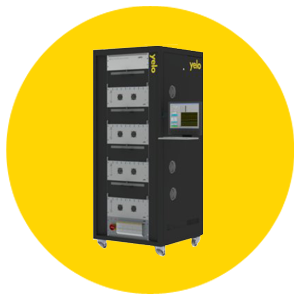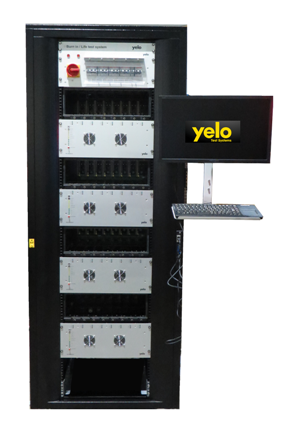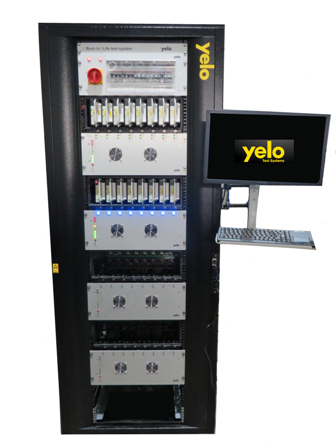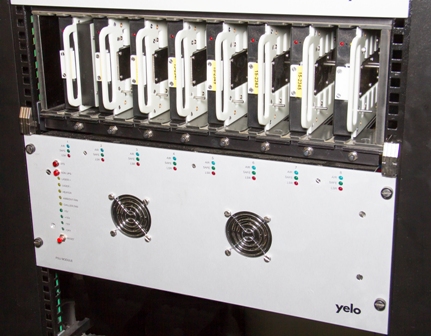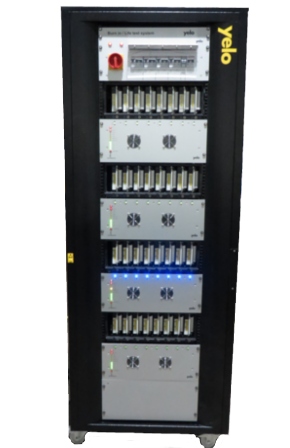Y1000L LOW POWER
Laser Diode Reliability Life Test & Burn In System
Easily test the reliability of your low power laser devices with the Y1000L burn-in and life-test system. it will quickly identify defective devices so you can prevent them reaching your customers. Y1000L's full automation and expandable capacity helps you work through your tests more productively. And its user-friendly software makes testing your devices easier than ever.
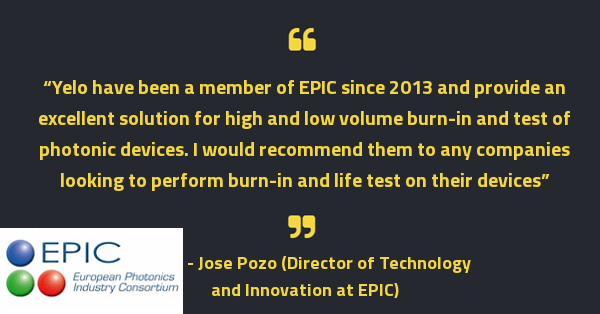
Used for Burn-In, Life Test and Vendor Qualification.
Custom built to your specification with NIST standard instruments
Ideal for testing low power devices up to 1Amp
Distinctive and space-saving design.
Fully Expandable to test up to 2048 devices
Capable of burn-in for QFSE, SPF+ and 10G, 40G and 100G networks.
GALLERY
SPECIFICATION
- Benefits
- Features
- Supported Devices
- Yelo Probed Burn In
- Tunable Laser Reliability
- 100G, QSFP, SFP + Testing
PRODUCTIVITY AT ITS BEST
Your devices are placed into mini oven modules, customized for your device. This allows you to test up to 2,048 devices and monitor and control each individual module’s test parameters, test duration, temperature, current and optical measurements. You can run your devices under test (DUT) for over 10,000 continuous hours with our proven laser drive cards.
SO MUCH, YET SO LESS
Y1000L is 27.5% smaller than standard industrial ovens. So you can test as many devices as possible, and take up less valuable clean room space.
Your devices are placed into mini oven modules, customized for your device. This allows you to test up to 2,048 devices and monitor and control each individual module’s test parameters, test duration, temperature, current and optical measurements. You can run your devices under test (DUT) for over 10,000 continuous hours with our proven laser drive cards.
SO MUCH, YET SO LESS
Y1000L is 27.5% smaller than standard industrial ovens. So you can test as many devices as possible, and take up less valuable clean room space.
RELIABILT 2015 BURN-IN SOFTWARE
A clear user interface displays the status of your device under test (DUT). Easily graph all your test data including LIV sweep analysis and spot measurements. Get test notifications via email and set conditions for each test to decide pass/fail parameters.
GIVING YOU THE INFORMATION YOU NEED
Receive valuable test data for your devices including infant mortality failure rates, random wear out failure rates and usage wear out rates.
FASTER THROUGHPUT
Using GPIB controlled instruments, measurements are performed in less time saving hours of test cycle time.
A clear user interface displays the status of your device under test (DUT). Easily graph all your test data including LIV sweep analysis and spot measurements. Get test notifications via email and set conditions for each test to decide pass/fail parameters.
GIVING YOU THE INFORMATION YOU NEED
Receive valuable test data for your devices including infant mortality failure rates, random wear out failure rates and usage wear out rates.
LASER DEVICE PROTECTION
Proven spike free laser drive cards and module circuitry will protect your devices from spikes and electrical overstress (EOS).
Proven spike free laser drive cards and module circuitry will protect your devices from spikes and electrical overstress (EOS).
FASTER THROUGHPUT
Using GPIB controlled instruments, measurements are performed in less time saving hours of test cycle time.
SYSTEM CAPACITY
Starting from 16 devices up to 2048 devices in 2 racks
TEMPERATURE CONTROL
Control Type: PID control
Temperature range: 25-150 oC
Multiple temperature control: Each module independent
Temperature accuracy: +/- 1 oC
DIMENSIONS (L X D X H)
80cm x 80cm x 195cm
UPS
Optional
MAXIMUM CURRENT FOR DEVICE
1A
CONTROL MODES
ACC, APC and LIV
Starting from 16 devices up to 2048 devices in 2 racks
TEMPERATURE CONTROL
Control Type: PID control
Temperature range: 25-150 oC
Multiple temperature control: Each module independent
Temperature accuracy: +/- 1 oC
DIMENSIONS (L X D X H)
80cm x 80cm x 195cm
UPS
Optional
MAXIMUM CURRENT FOR DEVICE
1A
CONTROL MODES
ACC, APC and LIV
- Laser diodes
- Laser bars/laser array
- VCSEL arrays, VCSEL bars
- Avalanche photodiodes (APD)
- PIN photodiodes
- VCSEL TO Headers, To-can
- Butterfly
- Transmitter optical sub assembly (TOSA)
- Dual in-line/Mini Dual in-line (DiL/MiniDil)
- Chip on carrier
- Bare chip
- Custom packages
- Photodiodes and Avalanche Photodiodes
Yelo's latest technology allows for the burn-in of photonic integrate circuits and laser/photodiode arrays/bars. By incorporating our high accuracy semiconductor tungsten probing methods, aligned to device contact pads, Yelo can achieve high device count burn-in while retaining all of the control and measurement of our standard system.
This novel approach allows our customers to push back the cost of their devices to lower cost components. With high device counts in compact chambers, you will be able to increase throughput and make your test activities more efficient. Devices can be tested when either packaged or in chip-on-carrier form.
This novel approach allows our customers to push back the cost of their devices to lower cost components. With high device counts in compact chambers, you will be able to increase throughput and make your test activities more efficient. Devices can be tested when either packaged or in chip-on-carrier form.
Yelo's burn-in and life-test systems are composed of tightly-controlled temperature environments that can perform component testing either on a continuous basis, or at the end of the burn-in period. This modular, flexible system is available in 2 options:
-
The low-power option can be used for low-quantity testing in the laboratory and can also be easily scaled to test up to 2,048 devices in production. This flexibility also allows for simultaneous testing in up to 128 different temperature zones.
-
The high-power option can test up to 960 devices in production, in up to 320 different temperature zones simultaneously.
WHAT IS A TUNABLE LASER?
A tunable laser is a laser which can have its wavelength changed in a controlled manner. All laser devices allow for small changes in output wavelength, however, only a handful of lasers allow continuous tuning over a significantly larger wavelength range.
WHAT TYPES OF TUNABLE LASERS ARE THERE?
There are many types and several categories of tunable lasers. They exist in gas, liquid and solid state. Some types of tunable lasers are dye lasers (liquid and solid state), transitional metal solid state lasers, semiconductor crystal and diode lasers, and free electron lasers.
WHAT ARE TUNABLE LASERS USED FOR?
Tunable lasers are often utilised in spectroscopy, photochemistry, and optical communications.
TYPES OF TUNABILITY
Single line tuning: no laser is completely monochromatic, all allow small variances in output frequencies. This is known as linewidth of laser transition.
Multi-line tuning: most lasers have a number of operable wavelengths. Weaker lines do not usually operate unless the gain on the strongest transition is suppressed.
Narrowband tuning: some types of lasers can have the length of their cavity modified. This allows them to be continuously tuned over a significant wavelength range. Some lasers can have a structure that changes with their temperature, allowing the wavelength to change.
Widely tunable lasers: some tunable lasers can have their output range modified by >50nm through the use of tunable Bragg mirrors or other technologies.
Yelo's Y1000L test system is capable of providing probed burn-in for 100G networks. Individual laser components can be tested with LIV measurements being performed in-situ during burn-in test cycles.
WHAT ARE 100G, SFP+ AND QSFP?
100G: A 100G network is comprised of 4 channels using 25Gb/s modules. Needs for optical network carriers are increasing in terms of bandwidth and capacity due to the demanding high-speed data services now offered. An industry standard was set for the modulation techniques used in 100G networks by the Optical Internetworking Forum (OIF).
SFP+: means enhanced small form-factor pluggable. It acts as an interface between a network device motherboard to a fibre optic network cable. It allows for data rates of up to 10Gb/s.
QSFP: is a quad small form-factor pluggable, consisting of four channels and is used to interface a device motherboard to a fibre optic network cable. It supports data rates from 4 x 10GB/s.
APPLICATIONS
100G optical networking is the current generation of network data transfer rate of data carriers. It facilitates server data transfer, and is crucial for effective cloud computing and networking among many companies who rely on high-speed internet and bandwidth capabilities. 100G Ethernet uses CFP modules, which support 10 x 10Gb/s (over short ranges) or 4 x 25Gb/s lanes for the optical connection. SFP+ modules have been developed for usage with optical networking. Originally the modules had transfer rates of 2.5Gb/s but this has developed over time to the 10Gb/s rates seen today. With the SFP+ module allowing up to 10Gb/s, the quad small form-factor pluggable uses 4 x 10Gb/s channels to become a 40G optical interface module.
GROWTH TRENDS OF INDUSTRY
With the continually increasing reliance on internet usage worldwide, and cloud computing becoming a dominant part of the data storage industry, there has been increased emphasis on improving data transfer rates through development and improvement of the optical networks. The next stage for optical networking is the 400G network. It is hoped that a solution for industry standardisation of modulation techniques can be achieved for this stage to aid in the transition from 100G across network carriers.
IMPORTANCE OF BURN IN AND LIFE TEST
For manufacturers, burn-in and life-tests for laser diodes involved in the optical interface modules is important as it will provide their consumers wit ha product of superior quality and reliability. Where efficiency in optical networking is of vital importance to data communications and telecommunications industries, high reliability laser diodes are crucial in providing this. Costly network downtime can be greatly reduced through the screening of laser diodes at all stages of production.For companies working with optical networks, it can be important to qualify vendor claims of module operating characteristics. There may be slight differences in operating conditions from those used in characterisation tests carried out by the manufacturer. These differences can lead to decreased life expectancy. It is therefore important that the user can fully understand how their laser diode devices will operate, and how this will effect the expected laser life-times.


